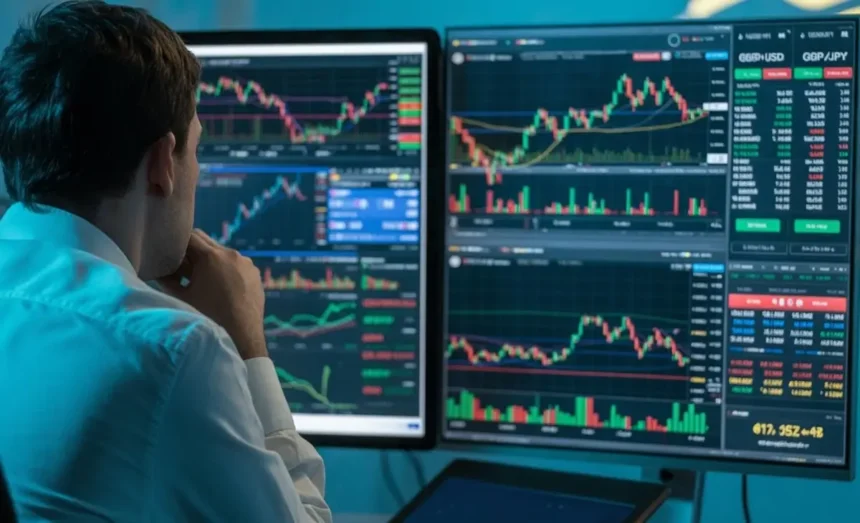The global currency markets represent one of the largest and most liquid financial markets in the world. Every day, trillions of dollars are exchanged across various currency pairs, reflecting the constant ebb and flow of economic activity, geopolitical events, and international trade. For investors, the foreign exchange market—commonly known as Forex Trading —offers a unique opportunity to participate in this dynamic landscape. Forex trading enables investors to navigate global currency markets efficiently, providing access, flexibility, and tools necessary to capitalize on market movements.
This article explores how forex trading empowers investors to interact with global currency markets, highlighting the efficiency it brings through liquidity, market accessibility, advanced technology, and strategic opportunities.
Understanding the Forex Market’s Unique Structure
At the heart of efficient navigation lies the forex market’s decentralized and over-the-counter (OTC) structure. Unlike traditional stock exchanges with centralized locations and fixed hours, forex operates 24 hours a day across different financial centers worldwide. This continuous trading environment allows investors to respond immediately to news and market developments, minimizing delays.
The decentralized nature ensures that currency trading is conducted directly between participants, including banks, financial institutions, corporations, and individual investors, facilitated by electronic networks. This structure fosters deep liquidity, meaning large volumes of currencies can be bought or sold quickly without causing significant price disruptions.
For investors, this means entering and exiting trades can be done swiftly and smoothly, allowing efficient capital allocation and timely responses to global events.
Access to a Wide Range of Currency Pairs
Forex trading offers exposure to a broad spectrum of currency pairs from major economies as well as emerging markets. These pairs are categorized typically as majors, minors, and exotics. Major pairs, such as the US Dollar against the Euro or Japanese Yen, represent the most actively traded and liquid options, providing tight spreads and consistent market activity.
Investors seeking diversification can explore minors and exotic pairs, which involve currencies from smaller or emerging economies. This diversity presents opportunities to capture movements influenced by different economic drivers, political conditions, or regional trends.
Such variety allows investors to construct well-rounded portfolios that reflect their risk appetite and market outlook, enabling efficient navigation by balancing opportunities across multiple currencies.
Liquidity and Tight Spreads Enhance Trading Efficiency
Liquidity is crucial for efficient market navigation because it determines how easily an asset can be bought or sold at stable prices. The forex market is renowned for its immense liquidity, especially among the major currency pairs. This ensures investors can execute trades quickly without significant slippage or price distortions.
Tight spreads—the difference between bid and ask prices—are another hallmark of the forex market’s efficiency. Narrow spreads reduce transaction costs, allowing investors to enter and exit positions with minimal expense. This is particularly important for active traders and those employing short-term strategies, where cost efficiency can significantly impact profitability.
The combination of deep liquidity and tight spreads ensures that forex traders can operate efficiently even in fast-moving markets.
Advanced Trading Platforms and Technology
Modern forex trading platforms are central to how investors efficiently navigate currency markets. These platforms provide real-time price quotes, advanced charting tools, and technical indicators that assist in analyzing market trends and identifying trading opportunities.
Interactive charts with multiple timeframes enable investors to evaluate currency movements from various perspectives, from minute-by-minute fluctuations to long-term trends. Integrated technical indicators such as moving averages, oscillators, and volume metrics help uncover momentum, potential reversals, and support or resistance levels.
Furthermore, many platforms offer customizable alerts and automated trading features, allowing investors to act promptly when market conditions meet their predefined criteria. Automated execution reduces the risk of missed opportunities and enhances precision in trade entry and exit.
With intuitive interfaces accessible via desktop and mobile devices, investors can monitor and manage their positions anytime, anywhere, facilitating efficient market engagement.
Use of Fundamental and Technical Analysis
Efficiency in forex trading is also achieved through the integration of fundamental and technical analysis. Fundamental analysis involves evaluating economic indicators, central bank policies, geopolitical developments, and other macroeconomic factors that influence currency values.
Investors monitor data such as inflation rates, employment figures, GDP growth, and trade balances, which collectively provide insight into the relative strength or weakness of a currency. This information helps forecast potential currency appreciation or depreciation, guiding strategic decisions.
Technical analysis, on the other hand, focuses on historical price data and patterns. Chart patterns, trendlines, and indicator signals assist investors in identifying entry and exit points based on market psychology and past behavior.
Combining both approaches allows investors to form well-informed trading decisions, enhancing the efficiency of navigating the complex forex environment.
Risk Management for Efficient Market Participation
Navigating the forex market efficiently requires effective risk management practices. Investors utilize various tools to manage exposure, including stop-loss orders, take-profit levels, and position sizing.
Stop-loss orders automatically close a position at a predetermined price, limiting potential losses if the market moves unfavorably. Take-profit orders lock in gains when a currency reaches a targeted price, ensuring profits are secured without needing constant market monitoring.
Careful position sizing relative to the account balance helps avoid overexposure to any single trade, preserving capital and maintaining trading flexibility.
By incorporating these risk management techniques, investors can participate confidently and efficiently, minimizing unexpected setbacks.
24-Hour Market Access Supports Timely Reactions
The continuous operation of the forex market, spanning from Asia through Europe to North America, enables investors to respond promptly to global developments as they unfold. Unlike markets constrained by fixed trading hours, forex’s 24-hour availability means investors are not forced to wait until markets open to act.
This around-the-clock access allows for efficient capital deployment, with traders able to exploit opportunities triggered by breaking news, economic reports, or geopolitical events almost instantly.
For example, an unexpected policy announcement by a central bank in one region can be responded to immediately by investors worldwide, enabling efficient repositioning before broader market effects take hold.
The Role of Demo Accounts in Efficient Learning
Before committing real capital, many investors benefit from using demo accounts offered by brokers to practice trading without financial risk. These simulated environments replicate live market conditions, allowing users to familiarize themselves with trading platforms, execute virtual trades, and test strategies.
Demo accounts serve as essential learning tools that enhance efficiency by enabling investors to build competence and confidence before engaging in actual currency trading. This hands-on practice helps reduce errors and improves decision-making speed when transitioning to live markets.
Global Economic Interconnectedness and Forex Trading
Forex trading thrives on the interconnectedness of global economies. Currency values are influenced by international trade flows, capital movements, interest rate differentials, and political developments.
Investors who understand these interrelationships can anticipate how events in one part of the world may ripple through currency markets. For example, trade negotiations, commodity price shifts, or changes in economic policy often affect multiple currencies simultaneously.
Efficient forex traders integrate this macroeconomic awareness into their analysis, positioning themselves to capitalize on cross-currency relationships and hedge against adverse effects.
Liquidity Providers and Market Makers
Efficient market navigation also benefits from the role of liquidity providers and market makers. These entities facilitate continuous trading by offering buy and sell prices for currency pairs, ensuring market depth and stability.
Their presence reduces the risk of price gaps and improves order execution quality, allowing investors to transact promptly and at predictable prices.
Investors can thus focus on strategy implementation rather than being hindered by market inefficiencies or lack of counterparties.
Automation and Algorithmic Trading
Advances in technology have introduced automation and algorithmic trading to forex markets. Investors can deploy automated systems programmed to execute trades based on specific criteria, eliminating emotional bias and enhancing execution speed.
Such systems process vast amounts of data and react instantaneously to market conditions, increasing efficiency in trade management.
While automation is not mandatory, it represents a tool that many investors use to complement manual strategies and optimize market participation.
Advantages of Currency Trading Over Other Markets
Compared to other financial markets, forex offers distinct advantages that contribute to efficient market navigation. Its global scale, extensive liquidity, and continuous operation create a flexible environment for investors.
Additionally, currency markets often react quickly to global news, providing timely opportunities. The diversity of currency pairs available allows for portfolio diversification and tactical allocation.
This combination of factors makes forex a uniquely accessible and responsive market for investors aiming to manage their exposure to international financial dynamics.
Challenges and Considerations
Despite its advantages, efficient navigation of forex markets requires awareness of inherent challenges. Currency prices can be affected by unpredictable geopolitical risks, sudden economic shifts, and market sentiment changes.
Investors must remain vigilant, continually updating their knowledge and adjusting strategies accordingly. Sound money management and disciplined trading remain critical to mitigating risks and maximizing the efficiency of market participation.
Conclusion
Forex trading equips investors with the tools and access needed to navigate the global currency markets efficiently. Through a combination of vast liquidity, diverse currency pairs, advanced technology, continuous market access, and analytical resources, forex provides an environment where timely and informed decisions can be made.
Investors leveraging these features can react quickly to market changes, manage risk effectively, and implement strategies tailored to their objectives. While challenges exist, the structure and resources inherent to forex trading foster a level of efficiency that empowers investors to engage with global currency markets confidently and competently.
As international economies continue to evolve and interconnect, forex trading remains a vital avenue for investors seeking to participate actively in the worldwide flow of capital. Efficient navigation of these markets not only opens opportunities for profit but also serves as a strategic tool for managing currency exposure in an increasingly globalized financial landscape.







